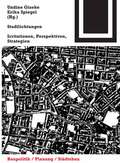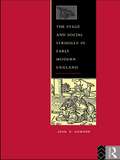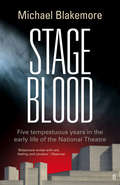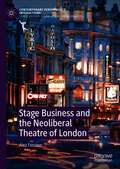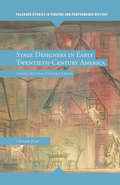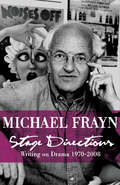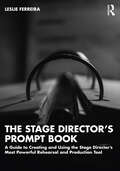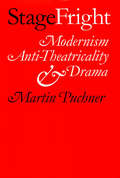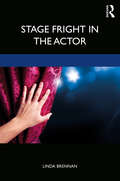- Table View
- List View
Städtebauliches Entwerfen
by Christa ReicherDas Lehr- und Grundlagenbuch „Städtebauliches Entwerfen“ gibt angehenden Architekten, Stadt- und Landschaftsplanern Hilfestellung bei der Bearbeitung von städtebaulichen Projekten und Entwürfen. Die dargestellten Inhalte und deren Aufbereitung orientieren sich an dem Entwurfsprozess in der Praxis und betten diesen in ein theoretisches Gerüst aus notwendigem Hintergrundwissen ein. Als Einstieg wird ein Überblick über das Verständnis von Stadt, von städtischen Strukturen und den hierin herrschenden Gesetzmäßigkeiten gegeben. Um das vielschichtige Gebilde der Stadt verständlicher zu machen, wird dieses in unterschiedliche Layer und Bausteine zerlegt. Die Vorgehensweise beim Städtebaulichen Entwerfen wird anhand der „Schichten-Methode“ in Form von aufeinander folgenden Phasen beschrieben. Beispiele von städtebaulichen Projekten und Wettbewerben illustrieren die einzelnen Entwurfsschritte.
Städtebauliches Entwerfen
by Christa ReicherDas Lehr- und Grundlagenbuch „Städtebauliches Entwerfen“ gibt angehenden Architekten, Stadt- und Landschaftsplanern Hilfestellung bei der Bearbeitung von städtebaulichen Projekten und Entwürfen. Die dargestellten Inhalte und deren Aufbereitung orientieren sich an dem Entwurfsprozess in der Praxis und betten diesen in ein theoretisches Gerüst aus notwendigem Hintergrundwissen ein. Als Einstieg wird ein Überblick über das Verständnis von Stadt, von städtischen Strukturen und den hierin herrschenden Gesetzmäßigkeiten gegeben. Um das vielschichtige Gebilde der Stadt verständlicher zu machen, wird dieses in unterschiedliche Layer und Bausteine zerlegt. Die Vorgehensweise beim Städtebaulichen Entwerfen wird anhand der „Schichten-Methode“ in Form von aufeinander folgenden Phasen beschrieben. Beispiele von städtebaulichen Projekten und Wettbewerben illustrieren die einzelnen Entwurfsschritte.
Stadterneuerung: Eine Einführung (Basiswissen Architektur)
by Gisela Schmitt Hildegard Schröteler-von BrandtDieses Buch vermittelt ausgehend von den aktuellen städtischen Herausforderungen ein elementares Grundverständnis und solides Basiswissen von den Aufgaben, Problemen und Handlungsansätzen der Stadterneuerung in der europäischen Stadt. Einführend werden die theoretischen Erklärungsmuster, der geschichtliche Kontext und das Planungsinstrumentarium dargestellt. Die nachfolgende systematische Betrachtung der aktuellen Handlungsanforderungen und Praxisfelder bietet einen grundlegenden Einstieg in die unterschiedlichen Philosophien der einzelnen Stadterneuerungsprogramme. Die Erneuerung der Städte im Kontext des ökonomischen und gesellschaftlichen Wandels ist ein Handlungsfeld, das sich durch die Geschichte der Stadtentwicklung seit dem Bestehen der Städte zieht. Stadterneuerung als geplante Anpassung bestehender städtischer Strukturen an veränderte wirtschaftliche und technische Rahmenbedingungen, neue ökologische Herausforderungen sowie neue Anforderungen des sozialen Zusammenlebens in der Stadt ist der Gegenstand dieses Grundlagenbuchs.
Stadterneuerung: Eine Einführung (Basiswissen Architektur)
by Gisela Schmitt Hildegard Schröteler-von BrandtDieses Buch vermittelt ausgehend von den aktuellen städtischen Herausforderungen ein elementares Grundverständnis und solides Basiswissen von den Aufgaben, Problemen und Handlungsansätzen der Stadterneuerung in der europäischen Stadt. Einführend werden die theoretischen Erklärungsmuster, der geschichtliche Kontext und das Planungsinstrumentarium dargestellt. Die nachfolgende systematische Betrachtung der aktuellen Handlungsanforderungen und Praxisfelder bietet einen grundlegenden Einstieg in die unterschiedlichen Programmatiken der Stadterneuerung. Die Erneuerung der Städte im Kontext des ökonomischen und gesellschaftlichen Wandels ist ein Handlungsfeld, das sich durch die Geschichte der Stadtentwicklung seit dem Bestehen der Städte zieht. Die Stadterneuerung – verstanden als geplante Anpassung bestehender städtischer Strukturen an veränderte wirtschaftliche und technische Rahmenbedingungen, neue ökologische Herausforderungen sowie neue Anforderungen des sozialen Zusammenlebens in der Stadt – ist der Gegenstand dieses Grundlagenbuchs. In dieser zweiten Auflage wurden alle Kapitel inhaltlich überarbeitet und aktualisiert.
Stadterneuerung im vereinten Deutschland – Rück- und Ausblicke: Jahrbuch Stadterneuerung 2017 (Jahrbuch Stadterneuerung)
by Uwe Altrock Detlef Kurth Ronald Kunze Gisela Schmitt Holger SchmidtDas vorliegende Jahrbuch blickt reflektierend auf 25 Jahre Stadterneuerung zurück, zieht Bilanz und zeigt Zukunftsperspektiven auf.Im Jahr der deutschen Wiedervereinigung fand sich mit dem Arbeitskreis Stadterneuerung an deutschsprachigen Hochschulen eine Gruppe von Fachleuten zusammen, die durch die Herausgabe eines „Jahrbuchs Stadterneuerung“ zu einer Institutionalisierung der fachlichen Debatte über Stadterneuerung beitragen wollten. Dabei bezogen sie sich auf ein zwar nicht mehr junges, aber erst wenige Jahre zuvor leitbildhaft konsolidiertes Feld der Stadtentwicklung. Mit der Herausbildung der „behutsamen Stadterneuerung“ hatte sich nach längeren Auseinandersetzungen in den 1980er Jahren in der alten Bundesrepublik ein Ansatz weitgehend durchgesetzt, der sowohl die städtebaulich-architektonische Substanz als auch die vorhandenen Nutzungen und Bewohner/innen besonders respektiert. Er verkörpert damit einen wesentlichen Ausdruck einer Wende in der Stadtplanung, bei der das rationale Planungsmodell durch ein eher kommunikatives ersetzt oder zumindest ergänzt, das Gott-Vater-Modell von Planung stark in Frage gestellt sowie die städtebaulich-architektonischen Leitbilder der „Moderne“ durch Prinzipien einer „Nachmoderne“ ersetzt wurden.
Stadtforschung: Gegenstand und Methoden
by Frank EckardtDas Lehrbuch wendet sich an Studierende der Architektur, Stadtplanung, Urbanistik, Kunst und Kulturwissenschaften. Es soll den Studierenden ermöglichen, für ihr Studium und ihre Studienprojekte eine theoretische und methodische Grundlage zur Hand zu haben. Dabei soll einerseits ein Übersichtswissen vermittelt werden, in welcher Weise unterschiedliche Herangehensweisen aus den Sozialwissenschaften genutzt werden können, um konkrete Probleme in Städten in einer systematischen und realistischen Weise zu untersuchen. Andererseits wird das Buch zu grundlegenden Fragestellungen der Stadtforschung Positionen vermitteln, die zu einem besseren interdisziplinären Verständnis führen sollen.
Stadtklanggestaltung: Konditionen einer neuen Entwurfs-, Planungs- und Entwicklungspraxis (Urban Studies)
by Thomas KusitzkyDer Klang ist ein elementarer Teil städtischen Lebens und Erlebens. Er ist sinnbehaftet und bedeutsam. In der Stadtgestaltung findet er jedoch, von der Lärmbekämpfung abgesehen, bislang kaum Berücksichtigung. Ausgehend von dieser Feststellung fragt Thomas Kusitzky nach den Konditionen einer bewussten Praxis der Stadtklanggestaltung und zeigt Ansatzpunkte für deren Etablierung auf. Dabei fragt er nicht nur nach der Rolle der Entwerfer*innen und Planer*innen, sondern betrachtet das gesamte Netzwerk der Akteur*innen, die durch ihr aufeinander bezogenes Handeln eine solche Gestaltungspraxis hervorbringen.
StadtLandschaften: Die neue Hybridität von Stadt und Land (Hybride Metropolen)
by Sabine Hofmeister Olaf KühneDas Buch befasst sich aus interdisziplinärer Perspektive mit dem Entstehen und der Entwicklung von StadtLandschaften. Diese StadtLandschaften lassen sich als Teil gesellschaftlicher Hybridisierungsprozesse deuten. Diese lassen sich nicht oder nur noch unzureichend mit modernistischen Konzepten dichotomen Denkens beschreiben. In dem Buch werden von den unterschiedlichen Autoren neben sozialen und ökologischen auch planerische und (infra)strukturelle Aspekte der Thematik angesprochen.
Stadtlichtungen: Irritationen, Perspektiven, Strategien (Bauwelt Fundamente #138)
by Undine Giseke Erika SpiegelSeit ihren Anfängen war die städtebauliche Planung auf Wachstum angelegt. Dieses Wachstum wird es nicht mehr geben. Wie die Bundesrepublik insgesamt werden auch die Städte zunehmend an Bevölkerung verlieren. Leerstände, Baulücken, größere Brachen werden tief in das bestehende Stadtgefüge eingreifen. Die Städte müssen in der Tat "umgebaut" werden, aber wie? Im vorliegenden Band untersuchen namhafte Fachleute aus unterschiedlichen Disziplinen die Rahmenbedingungen, die in Zukunft die Stadtentwicklung prägen werden. Ansätze für neue Strukturkonzepte und Planungsstrategien werden vorgestellt. Dabei kommt den zunehmenden Freiräumen besondere Bedeutung zu, nicht als "Ersatz" für Gebautes, sondern als eigenständiges Strukturelement, das den Städten eine neue Qualität verleiht. Eine Pflichtlektüre für alle, die für die Zukunft der Städte auf realistischer Basis nach neuen stadträumlichen Konzepten suchen.
Stadtökosysteme: Funktion, Management und Entwicklung
by Jürgen Breuste Stephan Pauleit Dagmar Haase Martin SauerweinDieses Lehrbuch zu Stadtökosystemen beantwortet wichtige Fragen, die sich zum ökologischen Aufbau, zu den Funktionen und zur sozial-ökologischen Entwicklung von Städten weltweit stellen. Ausgehend davon, wie sich Städte heute in einer immer stärker urban werdenden Welt entwickeln, werden ökologische Herausforderungen für Städte des 21. Jahrhunderts wie Ressourceneffizienz, Klimawandel, Moderation der Lebensqualität und Resilienz erläutert. Das Buch verbindet Theorien der Stadtentwicklung und Ökologie mit praktischen Anwendungen und Fallbeispielen und spürt auf diese Weise Verbesserungspotenziale sowie und Beispiele guter ökologischer Stadtentwicklung weltweit auf. Es zeigt, dass Städte bei weitem nicht nur Problemräume sind, sondern auch große Potenziale für ein gutes Leben bieten und dass dazu die verschiedenen Stadtökosysteme einen erheblichen Beitrag leisten können. Die „Ökostadt“ ist damit keine Utopie, sondern ein reales Ziel, das schrittweise unter Beachtung des lokalen und regionalen Kontexts gezielt angestrebt werden kann.Vier renommierte Stadtökologen haben ihre spezifischen Erfahrungen in Teilgebieten eingebracht, ohne den Blick für das Ganze dabei außer Acht zu lassen. Jürgen Breuste ist Stadtökologe und arbeitet an der Paris-Lodron-Universität Salzburg, Österreich, zu den Themen Nachhaltige Stadtentwicklung, urbane Biodiversität, Ökosystemdienstleistungen und Ökostädte. Dagmar Haase ist Landschaftsökologin und arbeitet an der Humboldt-Universität zu Berlin zu urbanen Ökosystemdienstleistungen und Themen der Landnutzungsmodellierung. Stephan Pauleit ist Landschaftsplaner und arbeitet an der Technischen Universität München zu Strategien für die nachhaltige Entwicklung von Stadtlandschaften. Martin Sauerwein ist Geograph und arbeitet an der Universität Hildesheim zur Geoökologie in Kulturlandschaften, Geoarchäologie und zum Bodenschutz. Das Lehrbuch spricht ein breites Publikum von Studierenden, Lehrenden und auch Praktikern im Bereich Ökologie, Stadtökologie, Stadtentwicklung, Nachhaltigkeit, Stadtgeographie, Natur- und Landschaftsschutz, Raumplanung, Landschaftsökologie, Sozialwissenschaften und Urbanistik an. Die zahlreichen Fotos und Grafiken, viele davon vierfarbig, sowie übersichtliche Tabellen illustrieren die Sachverhalte. Fallstudien, Beispiele und Erläuterungen erlauben einen vertiefenden Einblick. Fragen am Kapitelende ermöglichen eine Überprüfung des Wissensfortschritts, ein umfassendes Literaturverzeichnis zu jedem Kapitel weitergehende Studien.
Stadtverkehrsplanung: Grundlagen, Methoden, Ziele
by Gerd Steierwald Hans-Dieter Künne Walter VogtDas in der Fachwelt als Standardwerk eingeschätzte Buch behandelt die Probleme und Lösungsansätze der modernen Stadtverkehrsplanung. Ausgehend von der Einbindung der Verkehrsplanung in die Stadtplanung wird dem Leser eine grundlegende Darstellung zu den Methoden und Verfahren dieses weiten Fachgebietes vermittelt. Die als Hochschullehrer und Praktiker anerkannten Autoren behandeln die Grundlagen und Ziele der Planung, die Analyse und Prognose der Verkehrsentwicklung – insbesondere der Modellierung – und liefern nach den heutigen Erkenntnissen eine umfassende Übersicht über den Einfluss des Verkehrs auf alle Bereiche der humanen und natürlichen Umwelt einschließlich der Bewertung. Weitere Schwerpunkte bilden die Gestaltung und der Entwurf städtischer Verkehrsanlagen, bei denen der öffentliche Raum in der Stadt, die Straßen- und die Knotenpunkte, der ruhende Verkehr und die Anlagen des öffentlichen Verkehrs behandelt werden. Die neue Auflage wurde nicht nur gründlich bearbeitet und erneuert, sondern bringt zusätzliche Kapitel über Verkehrsleitbilder im Städtebau, Wirtschafts- und Güterverkehr, zur Leistungsfähigkeit von Verkehrsanlagen, zum Fußgänger- und Radverkehr, zu Verkehrsmanagement, Lichtsignalsteuerung, Technikfolgenabschätzung, Road Pricing und Planungsrecht. Die Darstellungen bieten dem Stadt- und Verkehrsplaner sowie Studierenden des Verkehrs- und Stadtbauwesens ein umfassendes Instrumentarium zur Lösung der gegenwärtigen Aufgaben, unter Berücksichtigung der wesentlichen Empfehlungen und Richtlinien.
Staffordshire Moorlands Pan (SEB)
by RnibThis dark green pan, discovered in Staffordshire in 2003, is made of copper alloy with a Celtic-style pattern inlaid with turquoise, blue, red and yellow-coloured enamel. It is quite small and could fit in the palm of the hand. Originally it may have had a handle, like that of a pan we use today, but is not attached now. The pan is circular with a small rim at the top and has a replacement base as the original base was missing when discovered. The rim and top of the base are nearly the same diameter, with the sides of the pan slightly curved from base to rim. About 5 mm from the rim, is an engraved inscription. Immediately below the inscription and extending to the base, is the Celtic-style patterning. The pattern is damaged in places due to the loss of the enamel but detail can still be clearly seen. It consists of a series of circles containing scrolling leaf shapes around a central flower motif. The tactile image is of a side view of the pan and shows the last 4 words of the inscription, along with 3 of the circles of the Celtic pattern and the triangular shapes between the circles. The rim and sides of the pan are shown as lines. The base is shown as solid texture. The shape of the letters in the inscription have been replicated exactly in a thick line. The Celtic pattern is shown with 4 types of textures - solid for the copper alloy, rough for the turquoise enamel, very rough for the blue enamel and hollows for missing enamel, mainly red. The triangular shapes between the circles are shown as a very rough texture, again for blue enamel.
The Stage and Social Struggle in Early Modern England
by Jean E. HowardThe Stage and Social Struggle in Early Modern England is a ground-breaking study of a controversial period of English literary, cultural, and political history. In language that is both lucid and theoretically sophisticated, Jean Howard examines the social and cultural facets of early modern theatre. She looks at the ways in which some theatrical practices were deemed deceptive and unreliable, while others were lent legitimacy by the powerful. An exciting and challenging work by one of the leading writers in the field, The Stage and Social Conflict in Early Modern England is important reading for anyone interested in the period.
The Stage and Social Struggle in Early Modern England
by Jean E. HowardThe Stage and Social Struggle in Early Modern England is a ground-breaking study of a controversial period of English literary, cultural, and political history. In language that is both lucid and theoretically sophisticated, Jean Howard examines the social and cultural facets of early modern theatre. She looks at the ways in which some theatrical practices were deemed deceptive and unreliable, while others were lent legitimacy by the powerful. An exciting and challenging work by one of the leading writers in the field, The Stage and Social Conflict in Early Modern England is important reading for anyone interested in the period.
Stage Blood: Five tempestuous years in the early life of the National Theatre
by Michael BlakemoreIn 1971, Michael Blakemore joined the National Theatre as Associate Director under Laurence Olivier. The National, still based at the Old Vic, was at a moment of transition awaiting the move to its vast new home on the South Bank. Relying on generous subsidy, it would need an extensive network of supporters in high places. Olivier, a scrupulous and brilliant autocrat from a previous generation, was not the man to deal with these political ramifications. His tenure began to unravel and, behind his back, Peter Hall was appointed to replace him in 1973. As in other aspects of British life, the ethos of public service, which Olivier espoused, was in retreat. Having staged eight productions for the National, Blakemore found himself increasingly uncomfortable under Hall's regime. Stage Blood is the candid and at times painfully funny story of the events that led to his dramatic exit in 1976. He recalls the theatrical triumphs and flops, his volatile relationship with Olivier including directing him in Long Day's Journey into Night, the extravagant dinners in Hall's Barbican flat with Harold Pinter, Jonathan Miller and the other associates, the opening of the new building, and Blakemore's brave and misrepresented decision to speak out. He would not return to the National for fifteen years.
Stage Business and the Neoliberal Theatre of London (Contemporary Performance InterActions)
by Alex FerroneThis book examines contemporary English drama and its relation to the neoliberal consensus that has dominated British policy since 1979. The London stage has emerged as a key site in Britain’s reckoning with neoliberalism. On one hand, many playwrights have denounced the acquisitive values of unfettered global capitalism; on the other, plays have more readily revealed themselves as products of the very market economy they critique, their production histories and formal innovations uncomfortably reproducing the strategies and practices of neoliberal labour markets. Stage Business and the Neoliberal Theatre of London thus arrives at a usefully ambivalent political position, one that praises the political power of the theatre – its potential as a form of resistance to the neoliberal rationality that rides roughshod over democratic values – while simultaneously attending to the institutional bondage that constrains it. For, of course, the theatre itself everywhere straddles the line of capitulating to the marketization of our cultural life.
Stage Combat Arts: An Integrated Approach to Acting, Voice and Text Work + Video (Theatre Arts Workbooks)
by Christopher DuValThe art of armed and unarmed stage combat thrills actors and audiences alike the world over. This book details many of the foundational techniques used by actors studying stage combat and actor-movement disciplines. A variety of specific training exercises are described that connect the actor's imagination to a cohesive and meaningful actor-training curriculum – integrating stage combat with the actor's process of developing a fully embodied awareness of the physical life of the character.Developing physical awareness and dexterity is an essential component of an actor's training and rehearsal processes. Engagement, connection, the ability to listen and respond with authenticity, clarity, flexibility, intentionality, tactical response, variety are all helpful aspects for the actor studying combat movement. With practical exercises and expert advice, Stage Combat Arts allows the actor to further hone their emotional connection and extension, breath and voice, intention and focus, movement and freedom, and their ability to connect physically to imagery and text – disciplines that are at the foundation of actor-training – all through the art of combat movement.
Stage Combat Arts: An Integrated Approach to Acting, Voice and Text Work + Video (Theatre Arts Workbooks)
by Christopher DuValThe art of armed and unarmed stage combat thrills actors and audiences alike the world over. This book details many of the foundational techniques used by actors studying stage combat and actor-movement disciplines. A variety of specific training exercises are described that connect the actor's imagination to a cohesive and meaningful actor-training curriculum – integrating stage combat with the actor's process of developing a fully embodied awareness of the physical life of the character.Developing physical awareness and dexterity is an essential component of an actor's training and rehearsal processes. Engagement, connection, the ability to listen and respond with authenticity, clarity, flexibility, intentionality, tactical response, variety are all helpful aspects for the actor studying combat movement. With practical exercises and expert advice, Stage Combat Arts allows the actor to further hone their emotional connection and extension, breath and voice, intention and focus, movement and freedom, and their ability to connect physically to imagery and text – disciplines that are at the foundation of actor-training – all through the art of combat movement.
Stage Designers in Early Twentieth-Century America: Artists, Activists, Cultural Critics (Palgrave Studies in Theatre and Performance History)
by E. EssinBy casting designers as authors, cultural critics, activists, entrepreneurs, and global cartographers, Essin tells a story about scenic images on the page, stage, and beyond that helped American audiences see the everyday landscapes and exotic destinations from a modern perspective.
Stage Directions: Writing on Theatre 1970-2008
by Michael FraynStage Directions covers half a lifetime and the whole range of Frayn's theatrical writing, right up to a new piece about his latest play, Afterlife. It is also a reflection on his path into theatre: the 'doubtful beginnings' of his childhood, his subsequent scorn as a young man and, surprisingly late in life, his reluctant conversion. Whatever subjects he tackles, from the exploration of the atomic nucleus to the mechanics of farce, Michael Frayn is never less than fascinating, delightfully funny and charming. This book encapsulates a lifetime's work and is guaranteed to be a firm favourite with his legions of fans around the world.
The Stage Director’s Prompt Book: A Guide to Creating and Using the Stage Director’s Most Powerful Rehearsal and Production Tool
by Leslie FerreiraThe Stage Director’s Prompt Book is a step-by-step, detailed guide on how to create a practical and powerful rehearsal and performance tool—the director’s prompt book. A prompt book is a coordinating and organizational tool for the stage director. This book systematizes the creative process the director uses to analyze and interpret a play and coordinates all director-related rehearsal and production activities into a single, self-contained interpretive and organizational system. This book guides the director through the necessary steps and stages of creating and using a prompt book—from play analysis and interpretation, through the formation of a dynamic and theatrical director’s vision, to a unique method of physicalizing a play in production. A prompt book of a one-act play is included in the book as a complete example of the system. Such techniques as redlining, color coding and creating a three-column left-hand page are vividly illustrated for readers, allowing them to assemble their own prompt books. In a clear and example-driven format, The Stage Director’s Prompt Book offers a system of directorial interpretation that takes the director through a series of point-by point instructions to construct a strong, effective and creative instrument for success. For the undergraduate and graduate student of theatre directing, stage management and producing courses, along with aspiring professional directors, this book provides an interactive and intuitive approach to personalize the stage directing experience and assemble a graphically dynamic and creative director’s prompt book.
The Stage Director’s Prompt Book: A Guide to Creating and Using the Stage Director’s Most Powerful Rehearsal and Production Tool
by Leslie FerreiraThe Stage Director’s Prompt Book is a step-by-step, detailed guide on how to create a practical and powerful rehearsal and performance tool—the director’s prompt book. A prompt book is a coordinating and organizational tool for the stage director. This book systematizes the creative process the director uses to analyze and interpret a play and coordinates all director-related rehearsal and production activities into a single, self-contained interpretive and organizational system. This book guides the director through the necessary steps and stages of creating and using a prompt book—from play analysis and interpretation, through the formation of a dynamic and theatrical director’s vision, to a unique method of physicalizing a play in production. A prompt book of a one-act play is included in the book as a complete example of the system. Such techniques as redlining, color coding and creating a three-column left-hand page are vividly illustrated for readers, allowing them to assemble their own prompt books. In a clear and example-driven format, The Stage Director’s Prompt Book offers a system of directorial interpretation that takes the director through a series of point-by point instructions to construct a strong, effective and creative instrument for success. For the undergraduate and graduate student of theatre directing, stage management and producing courses, along with aspiring professional directors, this book provides an interactive and intuitive approach to personalize the stage directing experience and assemble a graphically dynamic and creative director’s prompt book.
Stage Fright: Modernism, Anti-Theatricality, and Drama
by Martin PuchnerGrounded equally in discussions of theater history, literary genre, and theory, Martin Puchner's Stage Fright: Modernism, Anti-Theatricality, and Drama explores the conflict between avant-garde theater and modernism. While the avant-garde celebrated all things theatrical, a dominant strain of modernism tended to define itself against the theater, valuing lyric poetry and the novel instead. Defenders of the theater dismiss modernism's aversion to the stage and its mimicking actors as one more form of the old "anti-theatrical" prejudice. But Puchner shows that modernism's ambivalence about the theater was shared even by playwrights and directors and thus was a productive force responsible for some of the greatest achievements in dramatic literature and theater.A reaction to the aggressive theatricality of Wagner and his followers, the modernist backlash against the theater led to the peculiar genre of the closet drama—a theatrical piece intended to be read rather than staged—whose long-overlooked significance Puchner traces from the theatrical texts of Mallarmé and Stein to the dramatic "Circe" chapter of Joyce's Ulysses. At times, then, the anti-theatrical impulse leads to a withdrawal from the theater. At other times, however, it returns to the stage, when Yeats blends lyric poetry with Japanese Nôh dancers, when Brecht controls the stage with novelistic techniques, and when Beckett buries his actors in barrels and behind obsessive stage directions. The modernist theater thus owes much to the closet drama whose literary strategies it blends with a new mise en scène. While offering an alternative history of modernist theater and literature, Puchner also provides a new account of the contradictory forces within modernism.
Stage Fright in the Actor
by Linda BrennanStage Fright in the Actor explores the phenomena of stage fright—a universal experience that ranges in intensity from a relatively easy-to-conceal sense of anxiety to an overwhelming feeling of terror—from the actor’s perspective, unearthing its social, cultural, and personal roots. Drawing on her experience as both an actor trainer and a licensed psychotherapist, Linda Brennan recounts the testimonies of professional actors to paint a clear picture of the artistic, behavioral, cognitive, physiological, and psychological characteristics of stage fright. This book encourages the reader to reflect on their own experiences while guided by the stories of fellow actors. Their personal accounts, combined with clinical research and practical exercises, will help readers to identify, manage, and even conquer this "demon in the wings." Stage Fright in the Actor is an essential tool for actors and acting students. Its insight into the many manifestations of stage fright also renders it as valuable reading for acting/performing arts teachers and directors, as well as anyone who fears stepping "onstage."
Stage Fright in the Actor
by Linda BrennanStage Fright in the Actor explores the phenomena of stage fright—a universal experience that ranges in intensity from a relatively easy-to-conceal sense of anxiety to an overwhelming feeling of terror—from the actor’s perspective, unearthing its social, cultural, and personal roots. Drawing on her experience as both an actor trainer and a licensed psychotherapist, Linda Brennan recounts the testimonies of professional actors to paint a clear picture of the artistic, behavioral, cognitive, physiological, and psychological characteristics of stage fright. This book encourages the reader to reflect on their own experiences while guided by the stories of fellow actors. Their personal accounts, combined with clinical research and practical exercises, will help readers to identify, manage, and even conquer this "demon in the wings." Stage Fright in the Actor is an essential tool for actors and acting students. Its insight into the many manifestations of stage fright also renders it as valuable reading for acting/performing arts teachers and directors, as well as anyone who fears stepping "onstage."








